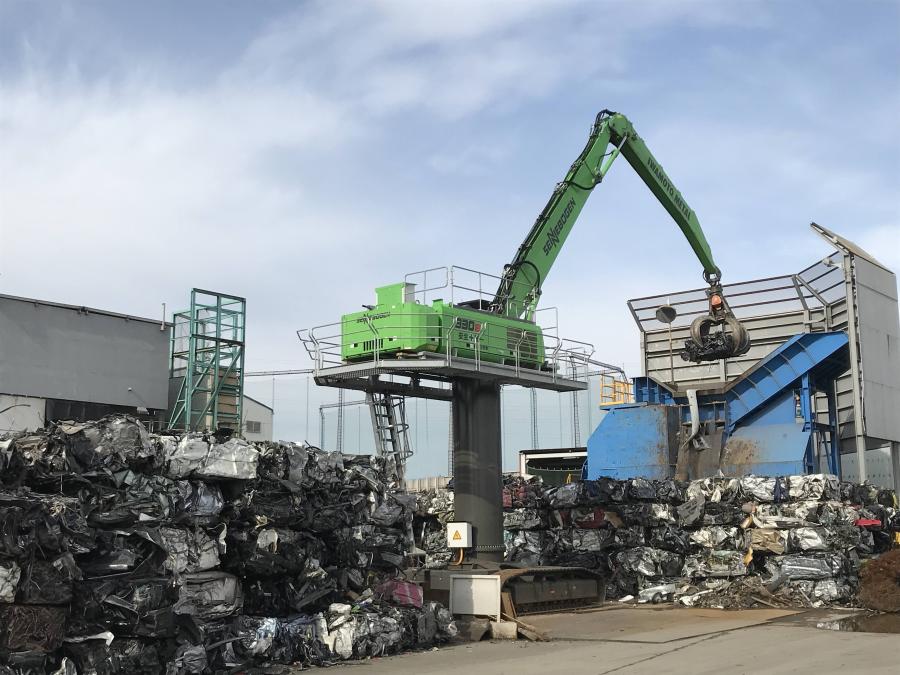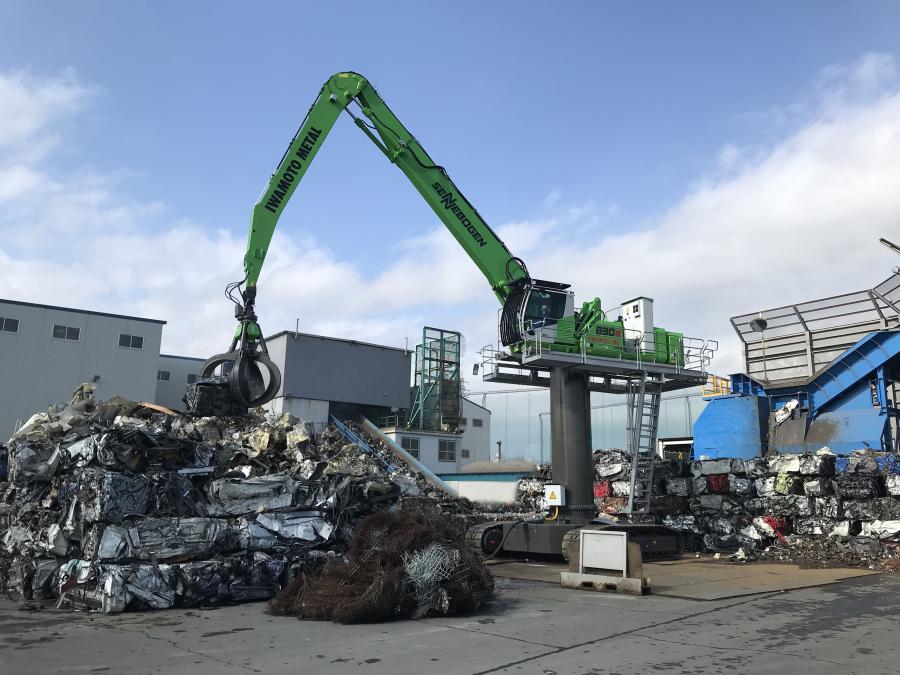Material handler with a crawler undercarriage on a 15 ft. pylon powered by a 180 hp electric motor. This machine was purpose-built for the material handling conditions of Iwamoto Metal Co. Ltd.'s largest plant.
When Iwamoto Metal Co. Ltd. converted its excavator into a material handling machine, it proved to be a useful short-term solution. However, when it was time to replace it, the company knew that its new machine had to be more powerful and more efficient in order to reduce operating costs.
The solution was a custom-built SENNEBOGEN 830 E with a 15 ft. pylon and powered by a 180 hp (132 kW) electric drive motor that was purpose-built to meet Iwamoto's material handling requirements on this site.
Iwamoto Metal Co. Ltd. is a major player in Japan when it comes to metal recycling. More than 90,000 tons of scrap metal is processed every month at 11 scrap yards spread across Japan. And with recycling experts predicting an increasing influx of scrap materials, particularly from the automotive industry, Iwamoto Metal Co. will only be busier as time goes on.
Modern Material Handler Replaces Modified Excavator in Metal Recycling
An influx of scrap means that machines are subjected to higher loads, required to process more material within the same time frame and every square foot must be used more efficiently.
Iwamoto Metal Co.'s new SENNEBOGEN acquisition will play a key role at the site, loading the metal scrap delivered by trucks and feeding the hopper of the 23 ft. high shredder. In fact, it was the reach and versatility that allowed for this decision to ultimately be an easy one.
Swapping out a converted earthmoving excavator with a machine that is purpose-built for material handling operations and has been customized for the material handling conditions at Eichigawa is like having your suits tailor-made… they fit perfectly and you always look your best regardless of the situation.
Differences Explained
What are the differences between an earthmoving excavator and a material handler?
"Excavators often reach their limits in recycling and scrap handling in terms of load capacity, engine power and cooling," explained Takeshi Iwanami, product expert at SENNEBOGEN's Japanese sales and service partner Sun Earth Co. Ltd.
Conditions in earthmoving differ from those in material handling: earthmoving excavators are designed to exert their force downwards, directly into the soil. Material handlers are designed to reach high heights with maximum payloads. In these situations, excavators don't have the necessary power or reach to maximize their onsite performance.
Increased Performance Through Customized Configuration, Electric Drive
In addition to being right-sized, Iwamoto Metal Co. Ltd.'s 830 E Series material handler continues to showcase the SENNEBOGEN philosophy that the more a machine is customized to the customer's needs, the more efficient it is. Furthermore, in order to be environmentally responsible while also reducing their operating costs, the company chose a SENNEBOGEN material handler with a 180 hp electric drive powerplant.
The 15-ft. pylon elevation provides the best possible view of the scrap piles being loaded on to the infeed deck of the 23 ft. high shredder. Due to the hydraulically raised Maxcab, the operator has a clear view of even the most remote corners from his vantage point now being 32 ft. This increases his efficiency while at the same time, reducing the risk of any accidents related to visibility challenges.
With a much better view, noticeably more power and precise control, the operator is genuinely pleased with the new machine.
"We are glad that we decided to go with the electric material handler. The machine performs much better than its predecessor and the operating costs are much lower," said Hiroshi Iwamoto, managing director of Iwamoto Metal Co. Ltd.
Scrap Handlers Versus Excavators: Built for A Purpose
Iwamoto Metal Co. Ltd. has seen first-hand how a purpose-built scrap handler is better suited to their operation than a converted excavator. But why is the difference so pronounced? The key is the difference in purpose: one machine is built to lift heavy weights above ground, while the other is supposed to dig deep below ground level.
That difference in geometry means a lot to the engineers who design such machines. The stresses on the structural components are distributed very differently, so the parts are designed to handle different points of wear. When an excavator is forced to reach up very high with a full load, the weight is transferred to places that were never intended to carry it. The same is true when you mount a high-rise cab on an undercarriage that was not designed to stabilize such a top-heavy-structure.
Excavators generate massive break-out forces to take big bites into the earth. Their booms, hydraulics and power train are all built for that purpose. But these forces are not needed to swing a grapple or magnet load of scrap. Instead, the scrap handler is built for speed, to lift high and swing fast. The engine power and heavy frame of the digging machine are simply a costly energy drain in scrap handling tasks.
What the scrap handler really needs is smooth handling and dampening of the vibrations so operators can run non-stop for entire shifts without fatigue.
Outwardly, the two machine types appear very similar, but closer examination shows you how engineers recognize their different purposes. For example, on a scrap handler, the hydraulic stick cylinder is positioned on the underside of the boom, to power the stick upwards to the top of its lift range. The stick cylinder of an excavator, however, is located above the boom, allowing to leverage the stick and bucket down into the earth more efficiently. The scrap handler also is designed to support its counterweight while the counterweight on a converted excavator is added as an afterthought.
Both machines are built for a purpose. Choosing the machine that is built for your purpose will pay off in performance, uptime, efficiency and safety.
For more information, visit www.sennebogen-na.com.

The 15 ft. pylon and the hydraulically raised 9 ft. Maxcab provides ideal visibility into the 23 ft. high shredder.
This story also appears on Aggregate Equipment Guide.
Today's top stories














